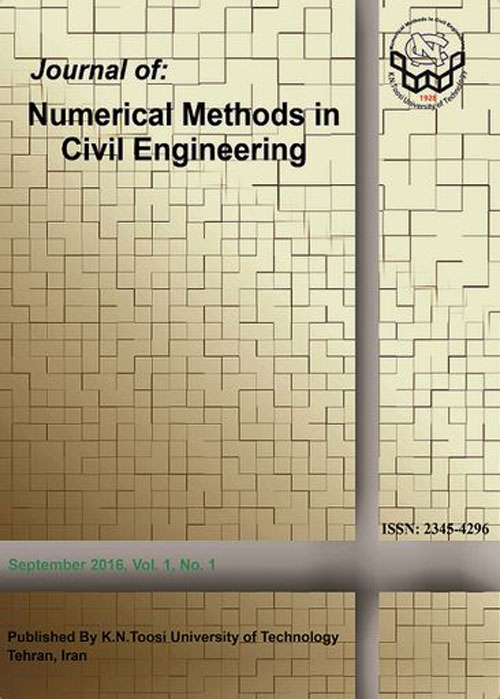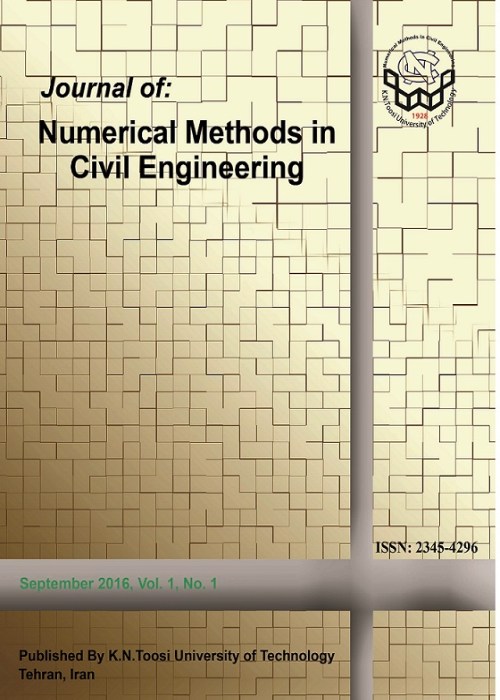فهرست مطالب

Journal of Numerical Methods in Civil Engineering
Volume:2 Issue: 3, Mar 2018
- تاریخ انتشار: 1397/10/17
- تعداد عناوین: 6
-
-
Pages 1-13Fling-step and forward directivity are two important characteristics of near-field earthquakes. Forward directivity occurs when the rupture propagates toward the site and arises in fault‐normal direction for strike‐slip faults. Fling-step is the consequence of permanent ground displacement imposed by near-field earthquakes and arises in strike-slip faults in the strike parallel direction. Fling-step effect produces permanent displacement at the end the culmination of displacement time history. This effect is usually omitted from the main record using the standard processing methods and therefore, cannot be determined for different structures. Many studies were performed to obtain seismic response of different structures subjected to near-field earthquake having forward directivity. On the other hand, there are few references to investigate the effect of fling-step on seismic behavior of structures. For this purpose, 14 earthquake records with fling-step are selected in a way that important factors including fling-step, PGV, PGA and the energy application type are different. The selected records are applied to eccentrically braced frame structures with 3, 6, 9 and 12 stories. A nonlinear time history analysis is used to capture displacement and story-drift ratio responses. The results show that the fling-step effect has no significant impact on any of the considered structures and its effect can be neglected in the case of eccentrically braced frame structures.Keywords: Fling- Step, Near-Fault Earthquake, EccentricallyBraced Frame, Story Drift- Ratio, Displacement
-
Pages 14-29This paper presents investigation carried out, including experimental and numerical studies, on low-rise shear-dominated brick masonry structures for the calculation of force reduction factor R. Basic experimental tests were conducted on masonry constituent materials for mechancial characterization. In-plane quasi-static cyclic tests were conducted on twelve full scale brick masonry walls, to understand behavior of shear-dominated walls under in-plane lateral loads. The tests’ data were analyzed to obtain the lateral shear strength, elastic and inelastic displacement capacities and hysteretic response of walls to facilitate numerical modelling of masonry structures. The numerical study included incremental dynamic analyses of shear-dominated brick masonry structures for the derivation of structures’ response curves, correlating the ground motion severity with the inelastic displacement demand on structure. The ductility dependent R factor is computed by identifying the ground motion intensities: capable to initiate global yielding in the structure (PGAy) and that exceeding the limit state displacement capacity of structure (PGAu), respectively. The ratio of the two PGAu/PGAy provides estimate of structures’ R factor. The calculated R factor varies in the range of 1.20 to 2.74, with a mean of 1.64; 1.5 may be conservatively used in the design and assessment of considered structures.Keywords: Brick masonry, Behavior Factor, Seismic Response Modification Factor, Masonry Shear Walls
-
Pages 30-44Nowadays, due to the escalation in construction of high-rise structures, the need for selecting a proper resistant structural system against earthquake and wind has increased significantly. These systems should show an optimized use of materials and should be presented as a hard and efficient structure. A good example of a high efficient system in high-rise buildings can be indicated is, the tubular system that was introduced by Fazlur Khan for the first time. It has been applied in most tall buildings all over the world. The major weakness of these systems is shear lag which restricts the column capacity from functioning properly. An appropriate solution to resolve this problem is using a braced tube system. Also, because of increasing height of the structure, the use of braced tube structures alone is not effective to control the lateral structures. Therefore, a combination of the braced tube with the inner tube and belt truss is more efficient. This paper focuses on the behavior of the hybrid steel system of tube in tube with bracing and belt trusses. To this aim, some buildings were modeled with different structural systems and different number of stories and were analyzed in terms of shear lag in web and flange, lateral displacement and drift, and absorption percent of shear force under earthquake forces. From the results obtained, it can be concluded that the belt truss does not have a favorable impact on the shear lag in the flange, but it reduces drift significantly. In addition, by adding external bracing to tube in the tube structure with belt trusses, the performance of structure improved remarkably in the aspect of shear lag, lateral displacement and absorption percent of the shear force .Keywords: Tube in tube system, Belt trusses, Shear lag, Drift, and Tall buildings
-
Pages 45-57Substructuring in the finite element method is a technique that reduces computational cost and memory usage for analysis of complex structures. The efficiency of this technique depends on the number of substructures in different problems. Some subdivisions increase computational cost, but require little memory usage and vice versa. In the present study, the cost functions of computations and memory usage are extracted in terms of number of subdivisions and optimized mathematically. The results are presented in the form of tables which recommend the proper substructuring for different number of elements. A combined case is also considered which investigates balanced reduction of computational and memory cost for 2D problems. Several numerical examples are analyzed numerically to demonstrate the abilities and efficiency of the proposed computational algorithm for structured and unstructured mesh.Keywords: Substructuring, Finite element method, Structural optimization, Computational cost, Memory cost
-
Pages 58-66In hybrid simulation, the structure is divided into numerical and physical substructures to achieve more accurate responses in comparison to a full computational analysis. As a consequence of the lack of test facilities and actuators, and the budget limitation, only a few substructures can be modeled experimentally, whereas the others have to be modeled numerically. In this paper, a new hybrid simulation has been introduced utilizing Least Square Support Vector Machine (LS-SVM) instead of physical substructures. With the concept of overcoming the hybrid simulation constraints, the LS-SVM is utilized as an alternative to the rate-dependent physical substructure. A set of reference data is extracted from appropriate test (neumerical test) as the input-output data for training LS-SVM. Subsequently, the trained LS-SVM performs the role of experimental substructures in the proposed hybrid simulation. One-story steel frame equipped with Magneto-Rheological (MR) dampers is analyzed to examine the ability of LS-SVM model. The proposed hybrid simulation verified by some numerical examples and results demonstrate the capability and accuracy of this new hybrid simulation.Keywords: Hybrid simulation, Numerical simulation, MR damper, Hysteresis model, Least Square Support, Vector Machine (LS-SVM)
-
Pages 66-77In this paper, linear stability analysis of non-prismatic beam resting on uniform Winkler-Pasternak elastic foundation is carried out based on Eringen's non-local elasticity theory. In the context of small displacement, the governing differential equation and the related boundary conditions are obtained via the energy principle. It is also assumed that the width of rectangle cross-section varies exponentially through the beam’s length while its thickness remains constant. The differential quadrature method as a highly accurate mathematical methodology is employed for solving the equilibrium equation and obtaining the critical buckling load of simply supported beam. Several numerical results are finally provided to demonstrate the effects of different parameters such as elastic foundation modulus, nonlocal Eringen’s parameter and tapering ratio on the critical loads of an exponential tapered non-local beam lying on Winkler-Pasternak foundation. The numerical outcomes indicate that the critical loads of pinned-pinned beam decrease by increasing nonlocal parameter. Furthermore, results show that the elastic foundation enhances the stability characteristics of non-local Euler-Bernoulli beam with constant or variable cross-section. It is finally concluded that the effect of non-uniformity in the cross-section plays significant roles on linear stability behavior of non-local beam.Keywords: Critical buckling load, Nonlocal elasticity theory, Tapered beam, Elastic foundation, Differential quadrature method


